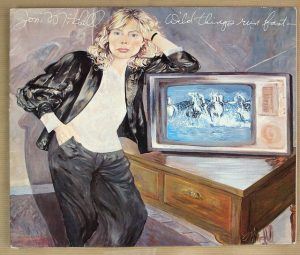Amit Chaudhuri at n+1:
 AROUND 2014, I began to talk to friends about Joni and was disappointed—surprised—by how little they knew. These were people who listened to music. I had a conversation about her with a highly accomplished ex-student in New York, a writer who had musical training, who thought I was talking about Janis Joplin. This was related to a problem: the plethora of Js among women musicians of the time, which led to their conflation into a genre. Janis Joplin, Judy Collins, Joan Baez, and Joni Mitchell: the last three especially were seen as interchangeable. Even if I put down my ex-student’s confusion to uncharacteristic generational ignorance, I found that, on mentioning Joni to a contemporary I had to work hard to distinguish her from Joan Baez. My friend had dismissed—not in the sense of “rejected,” but “taxonomized”—Joni as being part of a miscellany of singers with long, straight hair, high, clear voices, and a sincerity that shone brightly in the mass protests of the late ’60s. Visually, in her early acoustic performances with guitar, and even in her singing, she appropriated the folk singer’s persona to the point of parody, while the songwriting was absolutely unexpected. To prove this to my friend, I played her “Rainy Night House” and “Chinese Café / Unchained Melody.” It became clear in twenty seconds that Mitchell was not Joan Baez.
AROUND 2014, I began to talk to friends about Joni and was disappointed—surprised—by how little they knew. These were people who listened to music. I had a conversation about her with a highly accomplished ex-student in New York, a writer who had musical training, who thought I was talking about Janis Joplin. This was related to a problem: the plethora of Js among women musicians of the time, which led to their conflation into a genre. Janis Joplin, Judy Collins, Joan Baez, and Joni Mitchell: the last three especially were seen as interchangeable. Even if I put down my ex-student’s confusion to uncharacteristic generational ignorance, I found that, on mentioning Joni to a contemporary I had to work hard to distinguish her from Joan Baez. My friend had dismissed—not in the sense of “rejected,” but “taxonomized”—Joni as being part of a miscellany of singers with long, straight hair, high, clear voices, and a sincerity that shone brightly in the mass protests of the late ’60s. Visually, in her early acoustic performances with guitar, and even in her singing, she appropriated the folk singer’s persona to the point of parody, while the songwriting was absolutely unexpected. To prove this to my friend, I played her “Rainy Night House” and “Chinese Café / Unchained Melody.” It became clear in twenty seconds that Mitchell was not Joan Baez.
more here.
